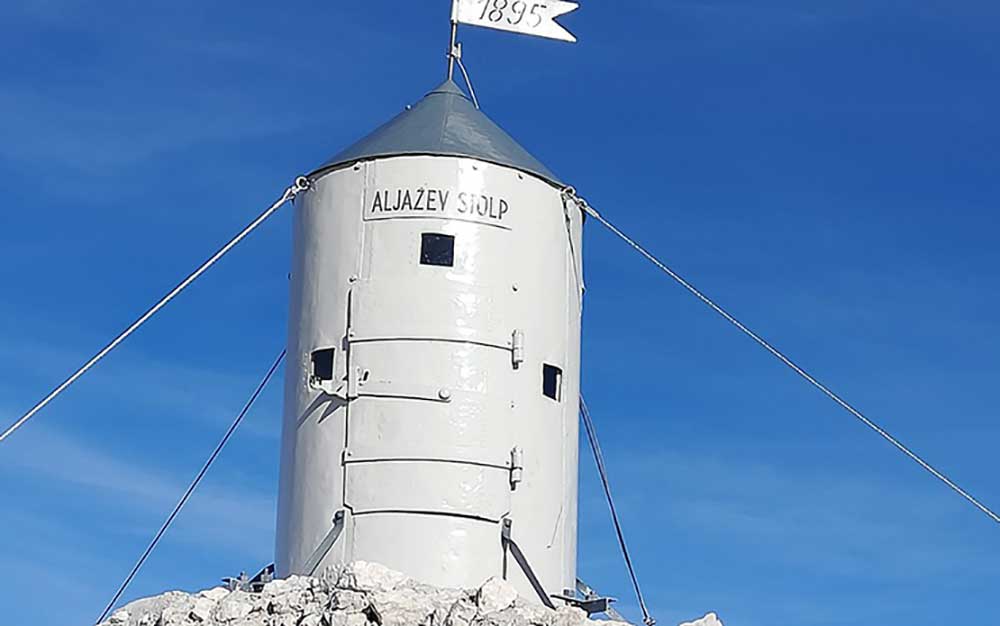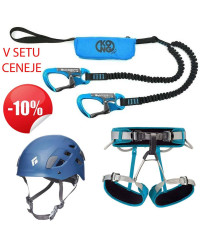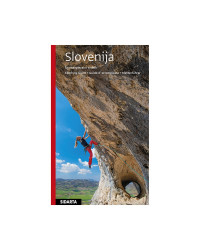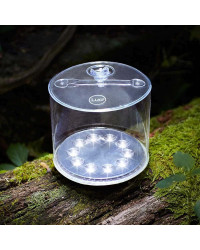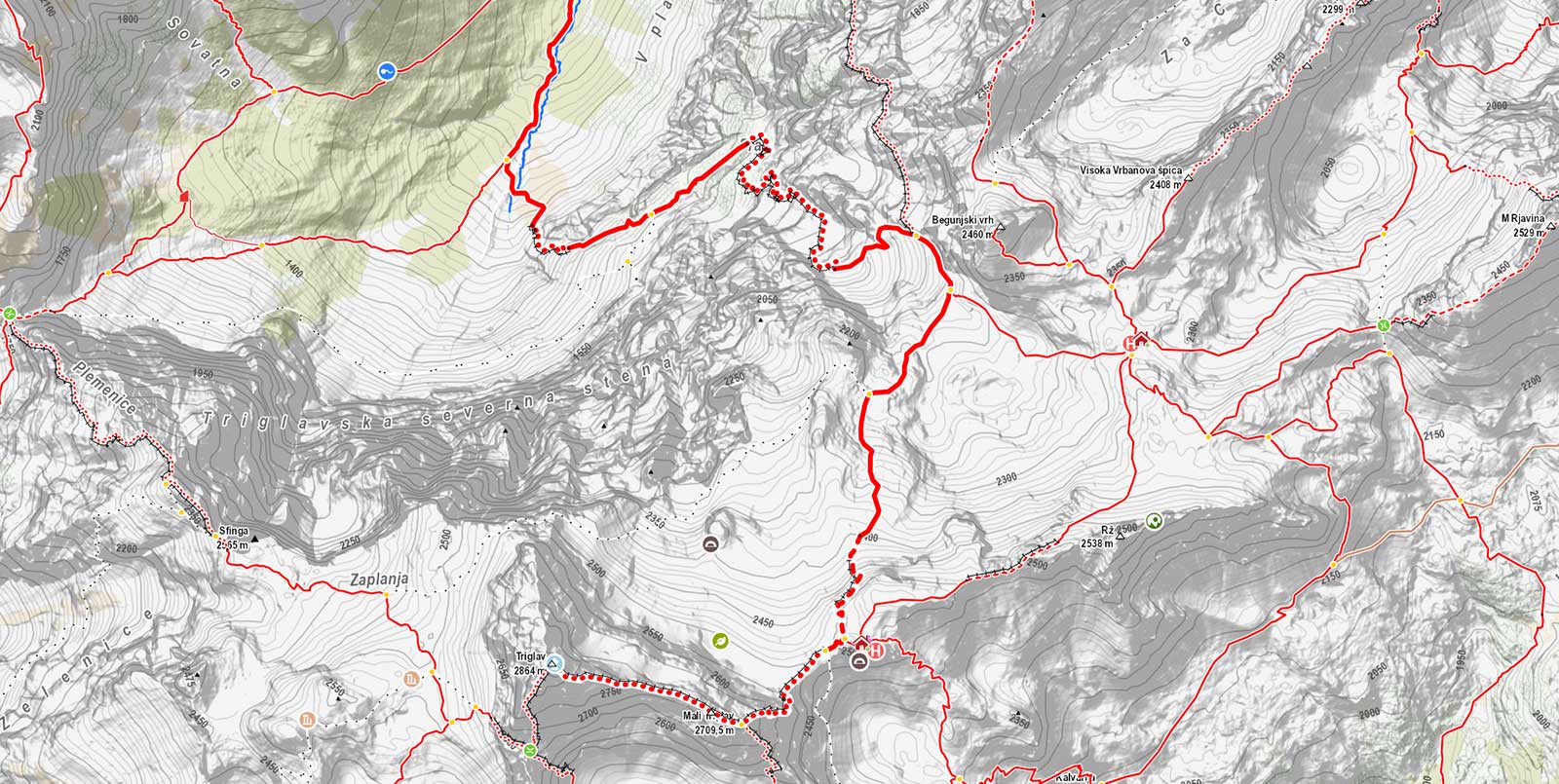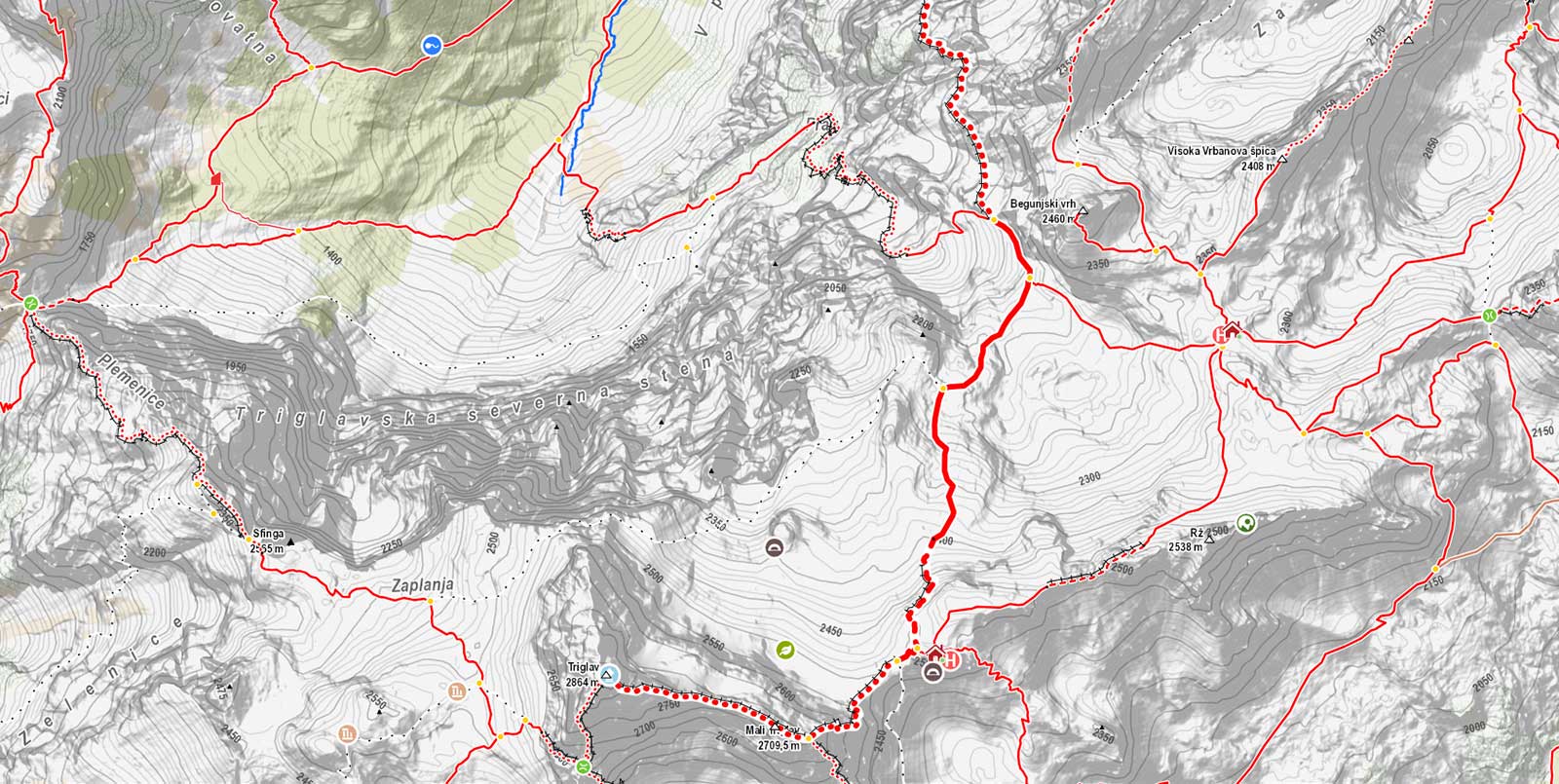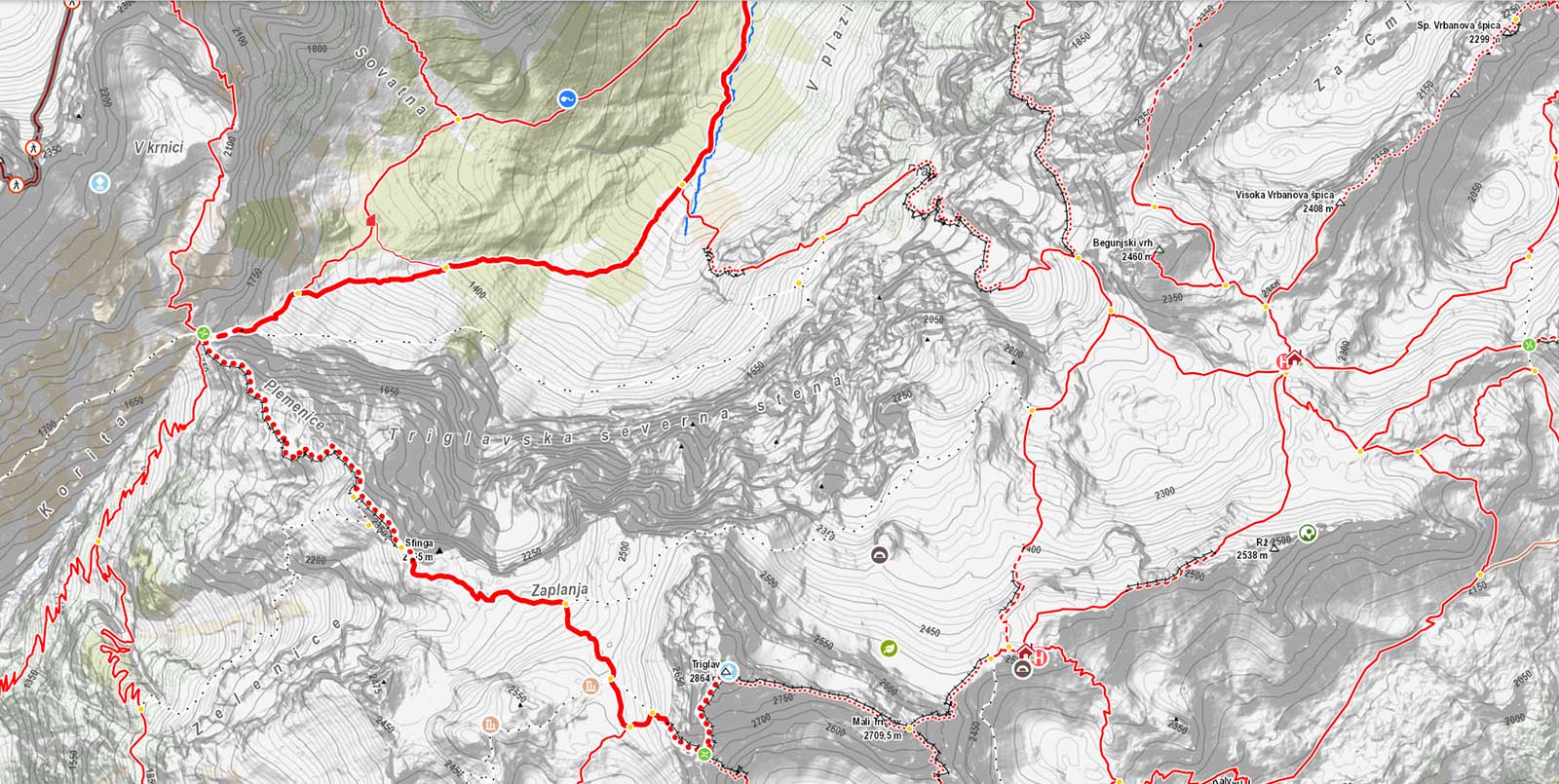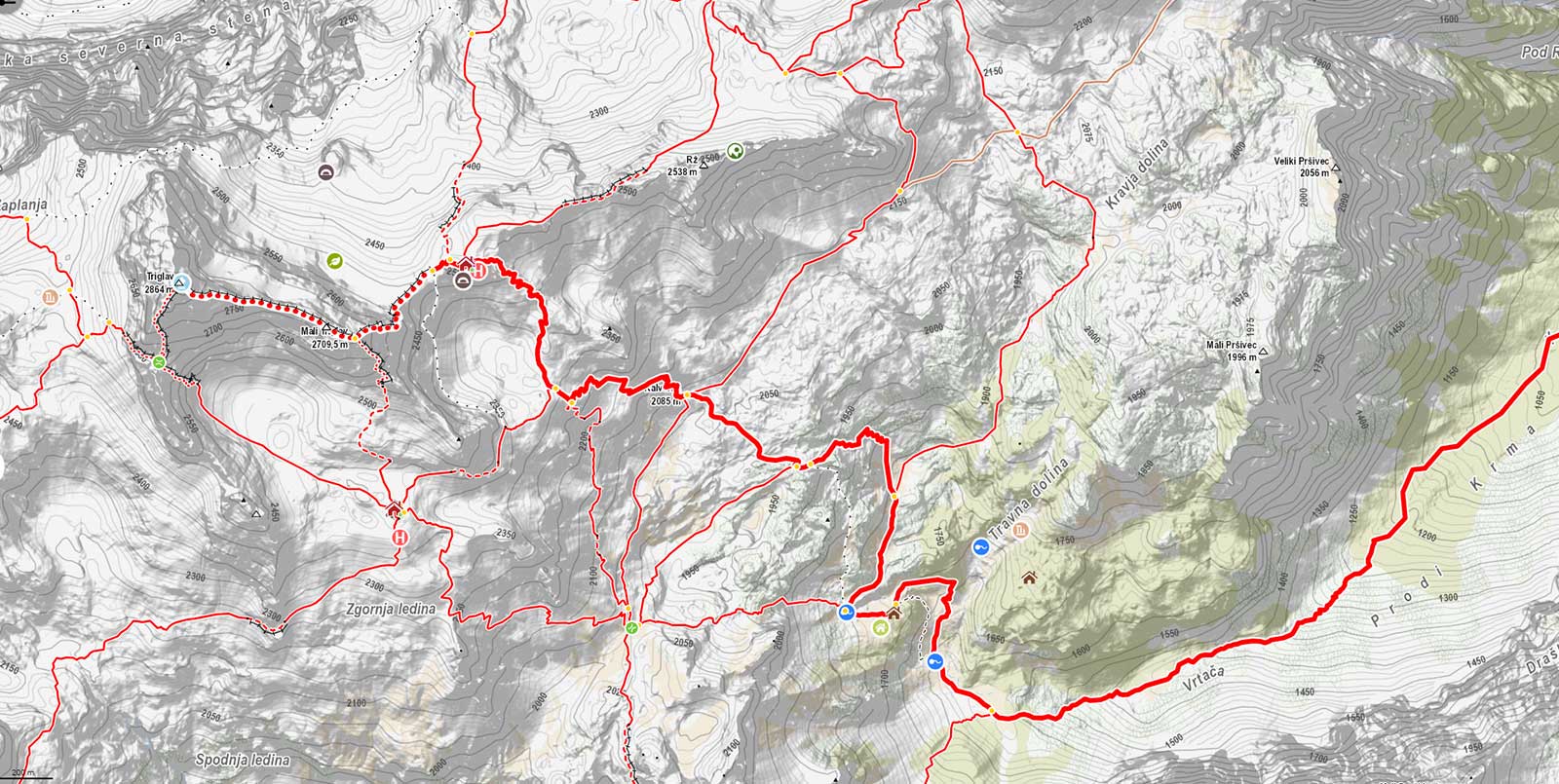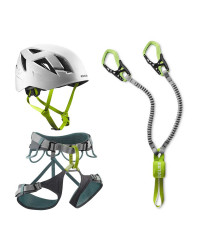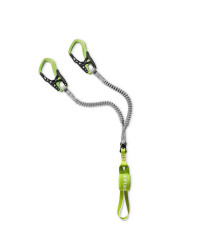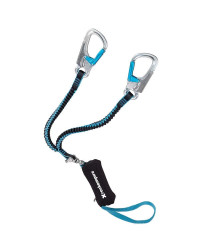We use cookies to make your experience better. To comply with the new e-Privacy directive, we need to ask for your consent to set the cookies. Learn more.
How to Climb Triglav: A Complete Guide
How to Climb Triglav
A Complete Guide
Popular routes to Triglav, Slovenia's highest peak. Paths from Vrata Valley, Krma, Bohinj, and Pokljuka. ✅ Perfect for hikers of all levels.
Welcome to Triglav - The Pride of Slovenia
Triglav 2,864 meters, the highest peak in Slovenia and the Julian Alps. Triglav is not just the highest peak in Slovenia; it's a national symbol that finds a place in the hearts of every Slovenian. Triglav is a magnet for mountaineers and nature enthusiasts.
Triglav, which translates to "three heads", is named for its distinctive triple-peaked summit.
The various hiking and mountaineering routes to Triglav to different levels of experience and expertise. This guide highlights the most popular routes to the Triglav.
Whether you're an experienced alpinist or a determined beginner, this guide will help you prepare for an unforgettable to the summit of Triglav.
How to Climb Triglav - Table of Contents
About Triglav, Location
Triglav is situated within Triglav National Park, the only national park in Slovenia, established to protect the diverse ecosystems and natural landscapes of the Julian Alps. The mountain can be accessed from various starting points, each offering a unique perspective and a range of experiences for climbers and hikers.
One of the most popular routes begins from Vrata Valley. This route is renowned for its dramatic views of Triglav's north face, a sheer, towering wall that has challenged mountaineers for generations. The Vrata Valley trail leads to the Aljažev dom v Vratih (1.001 m), a popular starting point for the ascent.
Another common starting point is the town of Bohinj, located at the foot of the Julian Alps. From Bohinj, climbers often head to the Savica Waterfall, a stunning natural attraction, and then proceed to the Triglav Lakes Valley. This route, also known as the "Valley of the Seven Lakes," is characterized by serene alpine meadows, crystal-clear glacial lakes, and diverse wildlife.
How to climb on Triglav
The ascent typically takes two days, with climbers spending the night at one of the mountain huts, known as *koče*. These huts provide basic accommodations and a chance to rest before tackling the final, most challenging section of the climb. The most famous of these is the Kredarica (2,515 m), which offers stunning views of the surrounding peaks and valleys.
The final ascent to the Triglav involves a steep and exposed ridge, requiring climbers to use fixed steel cables and pegs. This section, known as the "via ferrata," demands a good level of fitness and a head for heights. However, the effort is rewarded with breathtaking vistas and the satisfaction of reaching the summit.
When to Climb
Climbing to Triglav requires careful preparation, particularly for those unfamiliar with alpine conditions. The weather in the Julian Alps can be unpredictable, with sudden changes that can make the climb challenging. It is advisable to check weather forecasts and consult with local guides or park authorities before attempting the ascent.
The best time to climb Triglav is from June to September, when the weather conditions are most favorable. During these months, the trails are free of snow, and the mountain huts are open. Winter ascents are possible but require advanced mountaineering skills and equipment due to snow and ice.
Popular Routes
Whether you're an experienced alpinist or a casual hiker, there's a path to Triglav that will suit your capabilities. This guide explores the most popular routes to the Triglav, highlighting the characteristics, challenges, and attractions of each path.
Triglav has something for every adventurer. Whether you’re up for a challenging climb, a scenic hike around alpine lakes, or a winter ski tour, this mountain promises a unique and unforgettable experience. No matter which route you choose, it’s vital to be well-prepared, respect the environment, and prioritize safety.
With its cultural significance, stunning landscapes, and diverse routes, Triglav is a must-visit for any outdoor enthusiast.
The website mapzs.pzs.si is an interactive online platform that allows users to explore and plan hiking trails in Slovenia. Users can investigate various hiking routes, check their course, difficulty, and length, and access information about mountain huts and other important points. The site is an essential tool for all hiking enthusiasts who want to carefully plan their trips.
- Triglav Routes - Vrata Valley - Čez Prag
- Triglav Routes - Vrata Valley - Tominškova Path
- Triglav Routes - Vrata Valley - Bambergova Path, Čez Plemenice
- Triglav Routes - Krma Valley - Easiest
- Triglav Routes - The Pokljuka Route
- Triglav Routes - The Bohinj Route via the Seven Lakes Valley
1. Triglav Classic Route from Vrata Valley - Čez Prag
- Parking and starting Point: Aljažev dom v Vratih (1.001 m)
Parking costs: 25€ per day
- Walking time: 6 h
- Altitude difference: 1860 m
- Difficulty: Moderate to difficult
- Aljažev dom v Vratih - Triglav (čez Prag) - www.hribi.net
The classic route from the Vrata Valley is one of the most popular and iconic ways to reach the summit of Triglav. This path is steeped in history and is a favorite among Slovenians and international climbers alike. Begins at the Aljažev dom v Vratih (1.001 m), a popular starting point named after the famous priest and mountaineer Jakob Aljaž, who purchased the summit of Triglav in the late 19th century to protect it from private development.
The route first takes you through lush forests and then along the Bistrica River, eventually opening up to the breathtaking north face of Triglav, which rises dramatically above the valley. This ascent involves a mix of hiking and via ferrata, particularly in the final stages. The most famous section is the "Prag" (the Threshold), a steep and exposed area requiring caution and sure-footedness.
The path continues up through a rugged alpine terrain, offering stunning views of the surrounding peaks and valleys. Hikers will reach the Kredarica (2,515 m), the highest and most visited mountain hut in Slovenia, which serves as a common base for the final ascent. From Kredarica, top Triglav is usually reached within an hour, depending on conditions and experience. The final climb includes a via ferrata section and requires climbers to be equipped with Self-protection sets (via ferrata set, helmet, belt).
- Vrata - Begunjski studenec 3 h 30 min
- Begunjski studenec - Kredarica 1 h 30 min
- Kredarica - Triglav 1 h 10 min
Map and GPS Triglav via Čez Prag
2. Triglav via the Vrata Valley and Tominškova Pot
- Parking and starting Point: Aljažev dom v Vratih (1.001 m)
Parking costs: 25€ per day
- Walking time: 6 h
- Altitude difference: 1860 m
- Difficulty: Difficult
- Ferata: B
- Aljažev dom v Vratih - Triglav (Tominškova pot) - www.hribi.net
The Tominšek Route (Tominškova Pot) is another challenging path that starts from the Vrata Valley, near the Aljažev dom v Vratih (1.001 m). This route is known for its steep ascent and the spectacular views it offers of the north face of Triglav.
The trail initially follows the classic route but soon diverges, taking a more direct and steeper path up the mountain. The ascent is characterized by exposed sections and rocky terrain, making it more demanding than the classic route. Climbers will encounter several via ferrata segments, which require a good level of fitness and mountaineering experience.
As with other routes from the Vrata Valley, hikers typically aim to reach the Kredarica (2,515 m) before making the final push to the summit. The Tominšek Route is less crowded than the classic route, providing a more challenging and rewarding experience for those seeking a quieter path.
- Vrata - Begunjski studenec 3 h 20 min
- Begunjski studenec - Kredarica 1 h 30 min
- Kredarica - Triglav 1 h 10 min
Map and GPS Triglav via Tominškova Pot
3. Triglav via the Vrata Valley and The Bamberg Path (Čez Plemenice)
For experienced climbers, this via ferrata route offers a more challenging ascent. It requires technical climbing gear and a good head for heights. The Bamberg Path (Čez Plemenice) provides exhilarating sections along steep cliffs and breathtaking vistas.
- Parking and starting Point: Aljažev dom v Vratih (1.001 m)
Parking costs: 25€ per day
- Walking time: 6 h 30 min
- Altitude difference: 1849 m
- Difficulty: Difficult
- Ferata: B/C
- Aljažev dom v Vratih - Triglav (čez Plemenice) - www.hribi.net
Triglav via the Vrata Valley and The Bamberg Path (Čez Plemenice) is considered one of the most challenging and rewarding routes to the summit of Triglav. It is named after Karl Bamberg, a renowned Slovenian alpinist. The route begins in the Vrata Valley and shares its starting point with the classic route but quickly diverges, heading towards the iconic Aljaž Tower and the north face of Triglav.
This path is noted for its exposure and technical climbing sections, requiring a high level of mountaineering experience, and proper equipment. It involves a significant amount of via ferrata climbing, including the famous section known as "Brinova Škrbina," a narrow and exposed ridge that demands concentration and careful footwork. The Bamberg Route is less crowded than the classic route, offering a more solitary experience for those seeking a demanding climb.
The descent usually follows the classic route, allowing climbers to experience a different perspective of Triglav's stunning landscape.
- Vrata - Luknja 2 h 30 min
- Luknja - Zahodna Triglavska planota 3 h
- Zahodna Triglavska planota - Triglav 1 h
Map and GPS Triglav via Plemenice
4. Triglav via the Krma Valley (Easiest)
This route is the least technical, making it ideal for beginners. It starts from the Krma Valley and passes through lush forests and alpine meadows. The path is relatively gradual until you reach the final ascent, where some basic climbing is required.
- Parking and starting Point: Krma Valley (980 m)
Parking costs: free of charge
- Walking time: 6 h 10 min
- Altitude difference: 1955 m
- Difficulty: Moderate
- Krma - Triglav (čez Kredarico) - www.hribi.net
The Krma Valley route is another popular path to Triglav, particularly favored for its relatively gentle approach and scenic beauty. It is considered one of the easier routes, making it accessible to less experienced hikers who still wish to experience the thrill of summiting Triglav Slovenia's highest peak.
Starting in the Krma Valley (980 m), the trail gently ascends through forested areas and alpine meadows. The initial part of the hike is relatively straightforward, offering ample opportunities to enjoy the diverse flora and fauna of the region. As you ascend, the valley narrows, and the terrain becomes more rugged, leading hikers to the Planika (2,401 m) or the Triglavski Dom na Kredarici, both of which are common resting points before the final ascent.
The route from the Krma Valley is particularly popular in the winter for ski touring, given its wide and open slopes. However, it is important to note that winter ascents require special equipment and skills, including the ability to assess avalanche risk.
- Krma - Zgornja Krma 2 h 30 min
- Zgornja Krma - Kredarica 2 h 30 min
- Kredarica - Triglav 1 h 10 min
5. Triglav via Pokljuka
Starting from the Pokljuka Rudno polje, this route is slightly longer but offers a gentler ascent with stunning panoramic views. The trail leads through beautiful alpine pastures and the scenic Studorski Preval. Best for families
- Parking and starting Point: Pokljuka Rudno polje (1347 m)
Parking costs: 7 € per day
- Walking time: 6 h 30 min
- Altitude difference: 1800 m
- Difficulty: Moderate
- Rudno polje - Triglav (čez Kredarico) - www.hribi.net
The Pokljuka Route is a favored path for those seeking a more gradual ascent to Triglav. Starting from the Pokljuka Rudno polje (1347 m), which is renowned for its expansive forests and beautiful alpine meadows, this route offers a scenic and less strenuous approach to Slovenia's highest peak. The trail meanders through dense spruce forests and open pastures before reaching higher altitudes, where hikers are treated to stunning views of the surrounding Julian Alps. At the Vodnikov dom they have free drinking water, where you can fill up your reserves.
As the route ascends, it passes by the Planika (2,401 m) or the Triglavski Dom na Kredarici, both of which serve as ideal resting points before the final push to the Triglav. The Pokljuka Route is particularly popular for its accessibility and the gradual nature of the climb, making it suitable for a wider range of hikers, including families and those new to alpine trekking. Despite its relatively moderate difficulty, the route still provides a thrilling experience with its breathtaking landscapes and the rewarding feeling of standing atop Triglav.
- Rudno polje - Vodnikov dom 3 h 30 min
- Vodnikov dom - Kredarica 2 h
- Kredarica - Triglav 1 h 10 min
Map and GPS Triglav via Pokljuka
6. Triglav via the Seven Lakes Valley
- Parking and starting Point: Bohinj, Koča pri Savici (653 m)
Parking costs: 10 € per day
- Walking time: 8 h 45 min
- Altitude difference: 2530 m
- Difficulty: Moderate
- Koča pri Savici - Triglav (čez Triglavska jezera) - www.hribi.net
The Bohinj Route, often referred to as the Seven Lakes Valley Route, is one of the most scenic and tranquil paths to Triglav. Beginning at Bohinj, Koča pri Savici (653 m), just above the picturesque Bohinj Lake, this route takes hikers through the heart of the Triglav National Park, offering a journey rich in natural beauty. The trail winds through lush forests, alpine meadows, and past a series of stunning glacial lakes, known collectively as the Seven Lakes. Each lake, with its unique color and character, reflects the towering peaks that surround it, making this one of the most photogenic routes to the Triglav.
After passing the lakes, the trail becomes more challenging, leading hikers up steeper terrain towards the Zasavska koča na Prehodavcih (2,071 m), and then onwards to the Dolič Pass. From here, the path converges with the more direct routes to the Triglav. The Bohinj route via the Seven Lakes Valley is ideal for those who not only want to reach the Triglav but also wish to immerse themselves in the serene and diverse landscapes that the Triglav National Park has to offer.
- Koča pri Savica - Črno jezero 1 h 30 min
- Črno jezero - Dvojno jezero 1 h 30 min
- Dvojno jezero - Ledvica 1h
- Ledvica - Zeleno jezero 30 min
- Zeleno jezero - Hribarice 1h
- Hribarice - Dolič 45 min
- Dolič - Triglav 2 h 30 min
Map and GPS Triglav via the Seven Lakes Valley
Although this guide highlights some of the most popular and well-known routes, there are many other variations used by hikers and mountaineers. Each trail has its unique characteristics, ranging from different starting points to varying levels of difficulty and scenic beauty.
Some paths are more frequented, while others offer a more solitary and wild experience. From starting points in the Vrata, Krma, and Bohinj valleys to lesser-known approaches from other directions, Triglav offers something for everyone. It’s important to choose a route that matches your experience and physical condition, as conditions on the mountain can change rapidly.
In this guide, we have focused on some of the most important and popular routes, such as the classic route from Vrata, the path from Krma, the Bohinj route through the Seven Lakes Valley, and the routes from Pokljuka.
Preparation and equipment for a hike to Triglav
Ensure you are in good physical condition, as the climb involves significant elevation gain and can take up to 12 hours round trip, depending on the route. Hiking Triglav, Slovenia's highest peak, requires careful preparation and the right equipment to ensure a safe and enjoyable experience. Here’s a list of essential gear you’ll need:
Equipment rental
In case you do not have the appropriate equipment, you can rent equipment from world-famous brands at the best prices. Due to limited quantities, advance booking is recommended.
You can reserve the equipment in advance (up to one month) by purchasing in the alpline.si store or by emailing [email protected] and by phone: 040 754 760 or 040 728 330.
Via ferata sets rental (sorry only in Slovenian language)
Eequipment for a hike to Triglav
Hiking Boots
Proper hiking boots with good ankle support and a solid grip are vital, especially for rocky terrain and
steep sections.
Climbing Helmet
A helmet is crucial when ascending the exposed ridges or via ferrata sections near the
top Triglav to protect against falling rocks.
Harness and Via Ferrata
Set
For the final approach to the Triglav, a harness with a via ferrata lanyard ensures safety on steep,
iron-rung paths.
Layered Clothing
Weather can change quickly on Triglav. Wear moisture-wicking base layers, an insulating mid-layer, and a
waterproof jacket to stay warm and dry.
Gloves and Hat
Even in summer, temperatures can drop. Lightweight gloves and a hat will keep you warm during exposed
climbs.
Headlamp
For early starts or late finishes, a reliable headlamp is essential, especially if you are staying
overnight in a mountain hut.
Hiking poles
Poles help reduce strain on your knees during long descents and provide stability on uneven terrain.
Backpack (20-30 liters)
A medium-sized backpack is ideal for water, snacks, extra clothing, and emergency supplies.
Water and Snacks
Hydration is key, so carry enough water for the day. Bring high-energy snacks like nuts, dried fruit,
and energy bars for sustained energy. Wather in mountain hut is 6 € for 1,5l
Price list on Kredarica (every year beer price rise up for 1 €)
- Free drinking wather on Prehodavci
- Free drinking wather on Vodnikov dom na Velem polju (1,817 m)
- Free drinking wather on path via the Krma Valley
- Free drinking wather on path via the Vrata Valley
First Aid Kit
A basic first aid kit with bandages, blister treatment, pain relievers, and any personal medications is
essential for minor injuries.
Map or GPS application on phone
Even though Triglav is well-marked, having a physical map, compass, or GPS can be invaluable in case of
poor visibility or route confusion. We recommend the application mapzs.pzs.si and mapy.cz. Save maps for offline option!
Sunglasses and Sunscreen
High-altitude exposure means stronger UV rays. Protect your eyes and skin with polarized sunglasses and
high-SPF sunscreen.
Overnight Gear (if staying in a hut)
If you plan to stay overnight, pack lightweight sleeping bag liners and basic
toiletries, as most huts provide blankets. Single-use sleeping sheet: 6 €
Bringing the right gear ensures you’re ready for any challenge Triglav throws at you, allowing you to enjoy the beauty of the Julian Alps safely and comfortably.
Safety Tips
- Check Weather Conditions: Mountain weather can change rapidly. Always check the forecast before your climb.
- Start Early: To avoid afternoon storms and ensure you have plenty of daylight.
- Hydrate and Fuel: Carry enough water and energy-rich snacks.
- Stay on Marked Trails: Deviating can be dangerous and harmful to the environment.
- Know Your Limits: If conditions worsen or you feel unwell, don't hesitate to turn back.
Triglav FAQ-s
The best time to climb Triglav is from June to September when the weather is most stable and the paths are free of snow.
Triglav stands at 2,864 meters, making it the highest peak in Slovenia.
No permit is required, but booking a stay in a mountain hut is advisable.
Yes, if you are experienced and confident in your mountaineering skills. Otherwise, a guide is recommended.
It varies by route and fitness level. Typically tvo days. A round trip takes between 12 to 14 hours.
Essential gear includes sturdy hiking boots, a helmet, a harness, a via ferrata kit, and warm clothing. Crampons and an ice axe may be needed in early summer or late autumn.
Yes, older children with good fitness and experience in hiking can climb Triglav, especially on easier routes. However, caution and proper supervision are essential.
There are no fees to climb Triglav, but there may be charges for accommodation in mountain huts and parking at trailheads.
Wild camping is prohibited in Triglav National Park. Climbers are encouraged to use the designated mountain huts for overnight stays.
Yes, there are several local companies offering guided tours, which can be a good option for less experienced climbers.
Good physical fitness is required, as the climb can be strenuous and involve long hours of hiking and climbing.
Winter ascents are possible but require proper equipment, experience, and preparation due to the challenging conditions.
Triglav National Park is Slovenia's only national park, encompassing the Julian Alps and protecting the natural and cultural heritage of the area.
It is a tradition for first-time climbers to receive a symbolic "baptism" on the summit by being tapped with an ice axe, marking their achievement.
Mountain huts typically offer hearty Slovenian dishes like soup, goulash, sausages, Stew with dried meat (jota), Macaroni meat, Ham with eggs, as well as drinks like tea, coffee, beer and soft drinks.
Most mountain huts only accept cash, so it is advisable to bring sufficient euros for meals and accommodations.
In case of an emergency, you should call the Slovenian Mountain Rescue service at 112 and provide as much information as possible about your location and situation.
After climbing Triglav, visitors can explore attractions like Lake Bled, Lake Bohinj, the Vintgar Gorge, and the picturesque town of Kranjska Gora.
Triglav mountain huts
The mountain huts around Triglav offer essential shelter and rest for hikers on their travel to Slovenia’s highest peak. These huts provide safety, warmth, and food, while also offering breathtaking views of the Julian Alps. They are key stopovers that enhance the overall experience of exploring Triglav National Park.Dom Valentina Staniča (2,332 m)
Located on the northern side of Triglav, near Zgornje Kriško Lake, this hut offers a stunning view of the peaks above the Vrata Valley. It is a popular stop for mountaineers ascending Triglav from the east.
Kredarica (2,515 m)
The highest mountain hut in Slovenia and the most popular starting point for ascending Triglav. The hut
is open year-round and has a meteorological station. It provides shelter to numerous hikers heading to
the summit.
Planika (2,401 m)
This hut is situated just south of Triglav’s summit. It is a popular overnight spot for hikers climbing the classic routes from Pokljuka or Bohinj. The hut offers breathtaking views of the surrounding mountains.
Koča na Doliču (2,151 m)
Situated at the Dolič Pass between Triglav and Kanjavec, the hut offers a beautiful view of the Zadnjica Valley. It is popular among hikers approaching Triglav from the western side.
Vodnikov dom na Velem polju (1,817 m)
Located on the southern slopes of Triglav, beneath the majestic walls of Vernar, this hut is a popular stop for hikers ascending from Bohinj via Voj and Velo polje. It is an important waypoint on the way to Planika or Kredarica.
Zasavska koča na Prehodavcih (2,071 m)
This hut is located on a high ridge between the Valley of the Seven Triglav Lakes and the Soča Valley. It is an excellent starting point for exploring the Valley of the Seven Triglav Lakes and is often a stop for hikers on longer treks in the Julian Alps. The hut offers stunning views of the surrounding mountains.
The Aljaž Tower on Triglav
At the summit of Triglav stands the Aljaž Tower, a cylindrical metal structure that serves as a symbol of Slovenian sovereignty and pride. Built in 1895 by Jakob Aljaž, a Slovenian priest, mountaineer, and passionate advocate for the preservation of the mountain, the tower has become an iconic landmark. Aljaž purchased the land at the summit and constructed the tower to assert Slovenian ownership and protect it from foreign encroachment during a time of heightened national awareness.
The tower not only marks the highest point in Slovenia but also serves as a refuge for climbers in case of sudden weather changes. Inside, it houses a logbook where visitors can record their ascent, leaving messages and reflections on their experience. The Aljaž Tower is a powerful symbol of the nation's connection to the mountain and the enduring spirit of its people.
Triglav National Park
As Slovenia's only national park, Triglav National Park plays a crucial role in the conservation of the country's natural heritage. The park's management focuses on preserving its diverse ecosystems while promoting sustainable tourism. Efforts are made to balance the needs of visitors with the protection of the environment, ensuring that the park remains a pristine and accessible destination for future generations.
The park offers a range of outdoor activities, including hiking, climbing, and skiing. Well-marked trails and information centers provide guidance and education on the region's natural and cultural history.
Flora and Fauna in Triglav National Park
Triglav and its surrounding national park are a haven for biodiversity, boasting a rich tapestry of flora and fauna. The park's varied ecosystems range from alpine meadows and karst plateaus to dense forests and glacial lakes. This diversity supports a wide array of plant and animal species, many of which are endemic to the region.
In the lower elevations, visitors can encounter lush forests of beech, spruce, and fir. As the altitude increases, the vegetation shifts to alpine meadows, where hardy shrubs and vibrant wildflowers, such as edelweiss and alpine rose, thrive. The higher regions are characterized by sparse, rocky terrain, home to unique plant species adapted to the harsh conditions.
